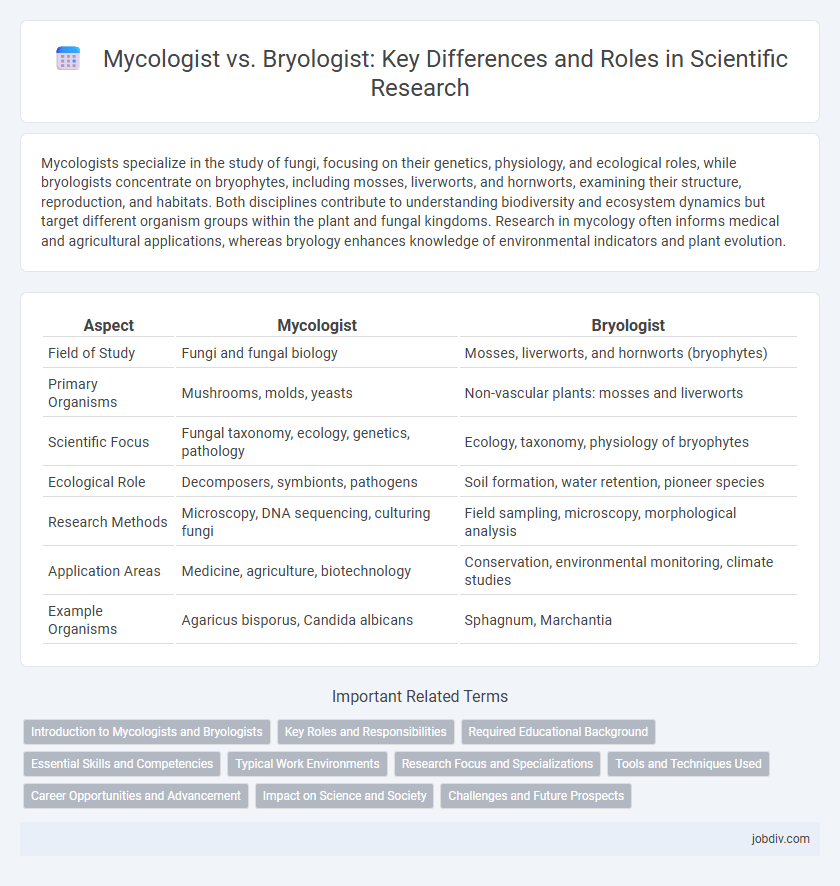Mycologists specialize in the study of fungi, focusing on their genetics, physiology, and ecological roles, while bryologists concentrate on bryophytes, including mosses, liverworts, and hornworts, examining their structure, reproduction, and habitats. Both disciplines contribute to understanding biodiversity and ecosystem dynamics but target different organism groups within the plant and fungal kingdoms. Research in mycology often informs medical and agricultural applications, whereas bryology enhances knowledge of environmental indicators and plant evolution.
Table of Comparison
| Aspect | Mycologist | Bryologist |
|---|---|---|
| Field of Study | Fungi and fungal biology | Mosses, liverworts, and hornworts (bryophytes) |
| Primary Organisms | Mushrooms, molds, yeasts | Non-vascular plants: mosses and liverworts |
| Scientific Focus | Fungal taxonomy, ecology, genetics, pathology | Ecology, taxonomy, physiology of bryophytes |
| Ecological Role | Decomposers, symbionts, pathogens | Soil formation, water retention, pioneer species |
| Research Methods | Microscopy, DNA sequencing, culturing fungi | Field sampling, microscopy, morphological analysis |
| Application Areas | Medicine, agriculture, biotechnology | Conservation, environmental monitoring, climate studies |
| Example Organisms | Agaricus bisporus, Candida albicans | Sphagnum, Marchantia |
Introduction to Mycologists and Bryologists
Mycologists specialize in the study of fungi, including mushrooms, molds, and yeasts, focusing on their genetics, ecology, and role in decomposition and symbiosis. Bryologists concentrate on non-vascular plants such as mosses, liverworts, and hornworts, examining their life cycles, habitats, and contributions to ecosystem functions like soil formation and moisture retention. Both disciplines contribute crucial insights into biodiversity and environmental health through their distinct yet complementary research on fungal and plant life.
Key Roles and Responsibilities
Mycologists specialize in studying fungi, including their genetics, ecology, and potential applications in medicine, agriculture, and industry. Bryologists focus on mosses, liverworts, and hornworts, analyzing their taxonomy, physiology, and ecological importance in ecosystems. Both scientists conduct field research and lab experiments but target distinctly different plant and fungal groups for biodiversity and environmental insights.
Required Educational Background
Mycologists typically require a bachelor's degree in biology, microbiology, or a related field, often followed by a master's or Ph.D. specializing in fungal biology or mycology for advanced research roles. Bryologists generally pursue similar foundational degrees but focus on botany, plant sciences, or ecology, with graduate studies emphasizing mosses, liverworts, and hornworts taxonomy and physiology. Both fields demand strong training in field research, laboratory techniques, and data analysis to study fungi or non-vascular plants effectively.
Essential Skills and Competencies
Mycologists require expertise in fungal taxonomy, microscopy, and biochemical analysis to study fungi's ecological roles and potential applications in medicine and agriculture. Bryologists must possess skills in moss identification, ecological surveying, and habitat assessment to understand bryophyte diversity and their role in ecosystem functions. Both disciplines demand proficiency in fieldwork, laboratory techniques, and data interpretation, but mycologists emphasize fungal physiology while bryologists focus on plant-like non-vascular species.
Typical Work Environments
Mycologists typically conduct research in laboratories, agricultural fields, or forest ecosystems studying fungi taxonomy, ecology, and applications in medicine or industry. Bryologists work primarily in natural habitats such as wetlands, forests, and tundra, examining mosses, liverworts, and hornworts to understand their ecology and role in the environment. Both specialists may also engage in academic institutions or environmental consulting firms to support biodiversity conservation and ecological studies.
Research Focus and Specializations
Mycologists specialize in the study of fungi, focusing on their taxonomy, genetics, and ecological roles in decomposition and symbiotic relationships. Bryologists concentrate on non-vascular plants such as mosses, liverworts, and hornworts, emphasizing their physiology, reproduction, and environmental adaptations. Both fields contribute critical insights into biodiversity and ecosystem functioning through specialized research methodologies.
Tools and Techniques Used
Mycologists primarily utilize microscopes and culture media to study fungi, employing techniques such as spore staining and DNA sequencing for identification and classification. Bryologists focus on mosses and liverworts, using tools like hand lenses and herbarium presses, combined with techniques including acid digestion and microscopy to examine cellular structures. Both specialists rely heavily on field sampling and laboratory analysis but adopt distinct methodologies tailored to their respective organisms' morphology and reproductive cycles.
Career Opportunities and Advancement
Mycologists specializing in fungi research often find career opportunities in pharmaceuticals, agriculture, and environmental conservation, emphasizing fungal ecology and pathology. Bryologists focus on mosses, liverworts, and hornworts, with career paths primarily in botany departments, ecological restoration projects, and climate change studies. Advancement for mycologists frequently involves interdisciplinary roles in biotechnology, while bryologists progress through academic research and specialized conservation efforts.
Impact on Science and Society
Mycologists and bryologists significantly contribute to scientific understanding and ecological preservation by studying fungi and bryophytes, respectively, which are essential for nutrient cycling and habitat formation. Mycological research advances medicine through the discovery of antibiotics and enzymes, while bryology informs climate change models via moss and liverwort responses to environmental shifts. Both disciplines influence conservation strategies and promote biodiversity, reflecting their profound impact on ecosystem health and societal well-being.
Challenges and Future Prospects
Mycologists face challenges including the complexity of fungal taxonomy and the need for advanced molecular techniques to uncover fungal biodiversity, while bryologists grapple with habitat sensitivity and climate change impacts on moss and liverwort populations. Both fields are advancing through genomic research and environmental DNA (eDNA) analysis, promising improved species identification and ecosystem understanding. Future prospects involve integrating multidisciplinary approaches and leveraging bioinformatics to address ecological roles and conservation strategies for fungi and bryophytes.
Mycologist vs Bryologist Infographic

 jobdiv.com
jobdiv.com